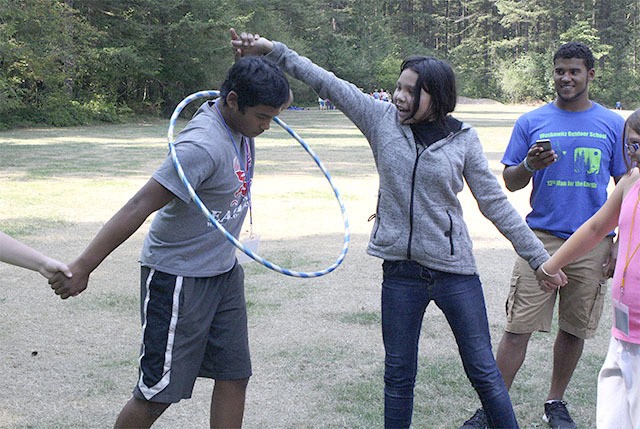When Rhonda Neufang was young, her school wouldn’t allow her to go to attend a tribe camp, because her tribe was not recognized. Because of that experience, she started a youth camp that would allow native kids to go regardless of their tribe affiliation.
“It was really hurtful. I didn’t want any kid to go through that because I want them to be proud of their heritage, proud of their upbringing, proud of what makes them them,” Neufang said. “I wanted to provide a youth camp that would allow all natives to go no matter if the tribe was recognized or not.”
Today, as Youth Camp Director, she has helped make that happen. More youth than ever before took part in the Snoqualmie Indian Tribe’s youth camp, Aug. 16 to 20 at Camp Waskowitz. Culture, health and fitness were the themes of the fourth annual camp, attended by 44 youth with native backgrounds, from grades 5 to 12.
Jim Bove, PR and Marketing Communications Officer for the Snoqualmie Tribe, said that their 44 campers weren’t just local kids, but are from all over the state.
“They are from any tribe, not just the Snoqualmie Tribe but throughout the state. The other tribes have been really good about pushing it out to their membership as well,” Bove said.
One camper, Jewel, age 16, said that her involvment with the Temporary Assistance for Needy Families program, as well as her blood relation to the Tlingit Haida tribe of Alaska, enabled her to come to the camp.
“I’m with TANF and they gave out forms to go to this camp because they wanted us to have a lot of opportunities…” Jewel said.
“I’ve been adopted by the Nooksack Tribe basically and I have been working with them for the past summer through TANF and that is how I got here.”
Part of why the camp had a health and fitness focus was to educate kids about things they may not learn in school. While working at a health clinic, Neufang saw how children were struggling with obesity and wanted to give them the opportunity to learn healthy habits, but in a fun way that engaged them more than a classroom would.
Health and fitness were only part of the camp. Neufang and the counselors also tied in culture and traditions from various tribes. Because the campers are from many different tribes, Neufang said they tried to incorporate them all by inviting guests to come in.
“Roger Fernandez, (of the Lower Elwha Band of S’Klallam Indians) he comes in and does great story telling,” Neufang said. “Every time he comes, the kids are quiet and you can see them on the edge of their chairs with anticipation.”
They also hired Angela Wymer, a language teacher, to teach the kids Lushootseed, the language spoken by many of the Salish Native American tribes of Washington. The campers were taught with cards featuring Lushootseed written phonetically and in English so they could practice it. Wymer is also taught them how to introduce themselves in the language.
Campers spent the week on various activities including arts and crafts, listening to stories, and playing lacrosse and football with the help of Seattle University and Pick 6 Sports.
In fact, the youth camp brought in many guests to help out with activities or give talks, including environmental groups, the Department of Natural Resources, University of Washington, and alcohol and drug awareness groups.
“We have mental health counselors who have been here, we have a police officer, we have some people from our clinic who have come in to talk about health and fitness, staff from our cultural activities area to kind of help with the craft and paddle-making,” Bove said.
Neufang and the counselors wanted to make sure the kids remembered to take all these lessons back home with them once camp is over.
“It’s great that so many people are willing to come out and give the kids tools to go home with,” Neufang said. “We made index cards for all the materials they are learning, so they can use it as a tool when they go home to not forget what they’ve learned.”
Neufang was happy with her work and being able to see the reactions from the kids makes it all worth it.
“I’m just really excited getting to work with the kids. Getting to see a side of the families and having them intermingle and having them grow together, learn together, and inspire each other is just great,” She said. “I really love it. Seeing the faces every year and seeing how excited they are is great.”

A volunteer from Seattle University leads a group of youth from various tribes in a chant before starting a team-building exercise. The exercise, and the arts and crafts work, left, were part of the Snoqualmie Tribe’s camp for Native American youth last week at Camp Waskowitz.

Campers made their own paddles during the youth camp.

Passing a hoop while holding hands is harder than it looks.

